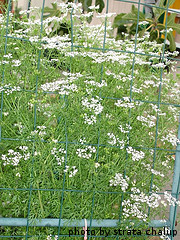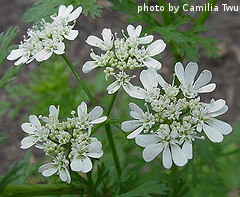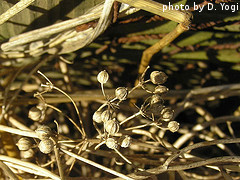Fertilizing and Watering Cilantro Plants
Once the seeds sprout and are a couple of inches tall, you should begin watering cilantro if you don't get any rain. Once the plants have flowered and are starting to set seeds, you can water less often. The plants will also do well with an occasional application of water-soluble fertilizer during the first few weeks of their life. You can also give the plants a head start by fertilizing your garden before you even plant, but more on that later.
Watering Cilantro Plants
Cilantro plants grow quickly and the soil needs to remain moist during the first few weeks of growth so that the plant can efficienty absorb nutrients. Water them gently so that no damage is done to the plants and the soil that is covering the root system is not eroded away. You can use a watering can, jog or a sprayer on the end of a hose. Just make sure the water pressure is low enough to avoid harming the plants.

Water your cilantro plants a couple of times a week to keep the soil cool and moist. You can also apply a thin layer of mulch to help the soil retain moisture. Straw, grass clippings, chopped up leaves, wet strips of newspapers, etc... work well as mulch and can be tilled under at the end of the growing season. Once the plants bloom and begin to set seeds, you won't have to water as often. The plants develop a lush canopy that shades the soil and keeps it moist for the most part. When seed production starts, stop watering all together so that the seeds will dry out more quickly and be ready for harvest.
To determine if your cilantro plants need watering, use your fingers and dig down a few inches into the soil next to your plants. Grab a handful of dirt and squeeze it in your palm. You want the dirt to be just moist enough that it holds together when squeezed for a few seconds, before falling apart. If the soil is visible wet and stays together when squeezed, let it dry out for a couple of days and check again. If the soil is dry and doesn't hold together at all when squeezed, you need to add water.
Fertilizing Cilantro Plants
Cilantro plants are best fertilized using a balanced, water-soluble fertilizer. Look for something that has close to equal parts of nitrogen, phosphate and potassium. Since you will be watering them a couple of times a week anyway, water-soluble fertilizers are the most convenient way to feed your cilantro plants. Just mix them with water according to the instructions on the package and spray onto the plants when you would normally water them. You can fertilize them every other time you water, or about once every 10-14 days. This will give them the boost they need to develop lots of edible foliage. Once the flowers appear and the plants begin to set seeds, you can stop applying fertilizer all-together.
You can use a granular fertilizer on your cilantro patch if so desired. However, be careful to add it only as a side dressing as it will sometimes burn the plants if it actual touches them. Most granular fertilizer products are applied at a rate of 1-1.5 pounds per 100 square feet. After scattering the granules, water them in well so they break down to a point that they can be absorbed by the plants.
In our own garden, we add fertilizer before we even plant our cilantro seeds. We till up the area and then scatter a balanced granular fertilizer at a rate of 1 pint per 100 square feet. We also scatter pulverized lime as our soil is a bit acidic and lacking in calcium. We then till the fertilizer and lime into the soil and then water it in well. We wait about a week before tilling one last time. We then use a shovel to build our raised rows and then plant our cilantro seeds. We find that this initial fertilizer application gives the plants a good boost when the seeds first germinate and sprout. After that, we switch to a water-soluble fertilizer product and apply it about once every 2 weeks.

If you are interested in growing cilantro organically, you can work some compost or well-rotted manure into the soil before planting. You can also choose from a wide variety of organic fertilizer products that are available at your local garden center. Things like fish emulsion works quite well for cilantro.
Now that you've learned about fertilizing and watering cilantro plants, it's time to think about harvesting the leaves and seeds.

Click here for information about harvesting cilantro and coriander seeds
Click here for some of our favorite coriander and cilantro recipes
Click here to move from our Fertilizing and Watering Cilantro page to our Growing Cilantro main page
Click here to go to our Home page